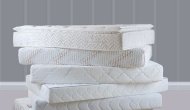Let’s talk about sleep—or rather, the struggle to get enough of it when back pain keeps you up at night. If you’ve ever woken up feeling like you’ve been in a wrestling match with your mattress, you’re not alone. Back pain is a common thief of rest, but the right mattress can make all the difference.
Waking up refreshed isn’t just about how long you sleep, but how well you’re supported. Whether you’re battling everyday stiffness or managing scoliosis, your mattress plays a bigger role than you might think. It’s not just a place to crash—it’s a partner in health.
Let’s break this down without the jargon together.
 How does the right mattress help reduce back pain? The right mattress supports your spine’s natural alignment, preventing sagging and muscle strain that can worsen back pain. Choosing materials like memory foam or latex helps distribute weight evenly, easing pressure on sensitive areas. Sleep position also matters—side, back, and stomach sleepers need different firmness levels. Overall, a supportive mattress can reduce chronic aches, especially for those with scoliosis or posture issues. Prioritizing proper mattress and pillow pairing can turn restless nights into restful, pain-free sleep.
How does the right mattress help reduce back pain? The right mattress supports your spine’s natural alignment, preventing sagging and muscle strain that can worsen back pain. Choosing materials like memory foam or latex helps distribute weight evenly, easing pressure on sensitive areas. Sleep position also matters—side, back, and stomach sleepers need different firmness levels. Overall, a supportive mattress can reduce chronic aches, especially for those with scoliosis or posture issues. Prioritizing proper mattress and pillow pairing can turn restless nights into restful, pain-free sleep.Overview
- Why Your Mattress Isn’t Just a Place to Crash
- Back Pain and Sleep: Frenemies
- Sleep Positions: The Good, The Bad, and The “Why Am I Like This?”
- Scoliosis: When Your Spine Has a Mind of Its Own
- Pillows: The Unsung Heroes
- Mattress Shopping Without the Guesswork
- A Closer Look at Mattress Brands
- When to Break Up With Your Mattress
- Final Thoughts (No Fluff)
Why Your Mattress Isn’t Just a Place to Crash

Imagine your spine as a string of pearls. If you lay it on an uneven surface, the pearls roll out of line. That’s what happens when your mattress doesn’t support your spine. Poor posture isn’t just about slouching—it’s a chain reaction. A saggy mattress lets your hips sink, your shoulders hunch, and suddenly, you’re waking up with a stiff neck or lower back that feels like concrete.
For those with scoliosis, the stakes are higher. The spine’s natural “S” or “C” curve already puts pressure on muscles and joints. A bad mattress can make that curve feel like a tightrope walk without a safety net. One customer, Sarah, shared how her old spring mattress left her hips aching every morning. Switching to a medium-firm latex model didn’t just ease her pain—it gave her the energy to keep up with her kids.
Back Pain and Sleep: Frenemies

Sleep should be a reset button for your body. But when your spine isn’t aligned properly, it’s like trying to charge a phone with a frayed cable—nothing works as it should. Poor support during sleep can turn minor aches into chronic issues. For example, one customer, Sarah, spent months blaming her desk job for her lower back pain—until she switched her decade-old sagging mattress for a supportive model. Within weeks, her stiffness improved.
The culprit? Mattresses that lack zoned support or fail to distribute weight evenly often force muscles and joints into awkward positions. Over time, this strains the spine. The fix? A mattress that adapts to your body, not the other way around.
Sleep Positions: The Good, The Bad, and The “Why Am I Like This?”

Your favorite sleep position is like your go-to comfort food—it feels right, but might not always be the best choice. Here’s the lowdown:
-
Side Sleepers (The Majority):
You need a mattress that hugs your hips and shoulders without squishing them. Memory foam is a star here—it moulds to your shape, easing pressure on joints. But avoid going too soft. A customer once bought a plush mattress thinking it’d cure his shoulder pain, only to wake up with his spine shaped like a question mark. We swapped it for a medium-foam hybrid, and within days, he said it felt like “sleeping on a cloud that knew his name.” -
Back Sleepers:
Goldilocks rules apply: not too soft, not too firm. A medium-firm mattress keeps your hips from sinking while cushioning your lower back. For scoliosis, this position is a win—it spreads weight evenly, like butter on toast. Pro tip: Tuck a pillow under your knees. It takes pressure off your spine and feels like a mini massage. -
Stomach Sleepers:
Let’s be honest—this position is rough on the body. But if you can’t kick the habit, go firm. A solid base keeps your spine from arching like a scared cat. Pair it with a thin pillow under your hips to avoid lower back strain. -
Combination Sleepers (The Nighttime Acrobats):
You need a mattress that’s adaptable. Latex or hybrids with pocket coils work wonders. They’re responsive enough to let you flip from side to back without feeling stuck. One couple we worked with—a combo sleeper and a scoliosis patient—opted for a hybrid model. Now they both sleep soundly, no midnight arguments over mattress preferences.
Scoliosis: When Your Spine Has a Mind of Its Own

Scoliosis isn’t just a curve—it’s a daily puzzle. The wrong mattress can feel like sleeping on a bag of potatoes; the right one? Like a custom-made hug. Here’s what to prioritize:
-
Material Magic: Memory foam and latex are your allies. They cushion uneven curves without letting sensitive areas sink. Avoid overly firm options—they’ll press on your ribs or hips like a thumbtack.
-
The Goldilocks Zone: Medium-firm is the sweet spot. One client with severe scoliosis found her pain halved after switching to a layered memory foam bed. The top layer cradled her shoulders, while the firmer base kept her spine aligned.
- Height Matters: Aim for 18–22 inches—high enough to sit down without a ladder, low enough to climb into without a running start.
Pillows: The Unsung Heroes

Even the best mattress needs a sidekick. Think of pillows as your spine’s backup dancers:
-
Back Sleepers: A pillow under your knees = instant lower back relief.
-
Side Sleepers: Wedge one between your knees to keep your hips aligned. Bonus: It stops that midnight leg shuffle.
- Stomach Sleepers: Skip the head pillow. Instead, slide a thin one under your hips to flatten your spine.
For scoliosis, get creative. A rolled towel under your lumbar curve or a contoured pillow can work wonders. One teen with scoliosis used a small pillow under her rib cage—her “magic spot”—and finally slept through the night.
Mattress Shopping Without the Guesswork

-
Memory Foam:
- Pros: Contours like a hug, blocks motion (ideal for partners who toss).
- Cons: Can trap heat. Look for gel-infused or open-cell foam.
-
Latex:
- Pros: Bouncy yet supportive, lasts longer than a Netflix series.
- Cons: Heavy and pricey, but worth the investment.
-
Hybrids:
- Pros: Best of both worlds—foam comfort with coil support.
- Cons: Edge support can vary. Test by sitting on the edge—if you slide off, keep looking.
-
Innerspring:
- Pros: Affordable and breathable.
- Cons: Springs can poke through over time, like a nosy neighbour.
A Closer Look at Mattress Brands

Kingsdown: Precision Engineering for Spinal Alignment
Kingsdown mattresses are like the Swiss Army knives of sleep—versatile, reliable, and packed with thoughtful details. Let’s start with their pocket coil systems. Unlike traditional innersprings that move as a single unit, these coils work independently. Imagine lying on a mattress that adjusts to your hips, shoulders, and lower back individually. That’s what Kingsdown delivers.
Their Cool Wave Memory Foam is another standout. It cradles pressure points (goodbye, hip pain!) without trapping heat—a common gripe with older memory foam designs. We've tested this material, and the cooling effect is subtle but noticeable, like swapping a heavy winter blanket for a breathable cotton sheet.
Then there’s the Posturized Centre Support, a feature that strengthens the middle third of the mattress. This is genius because it’s where most of your body weight sits. By reinforcing this zone, Kingsdown keeps your spine in a neutral position, whether you’re a back, side, or stomach sleeper.
Top Picks from Kingsdown:
- Athena Euro Top Firm Mattress: Mimics the luxury of five-star hotel beds with dual-coil systems for motion isolation
-
Kenrose Firm Tight Top Mattress: Combines zoned coils with plush foam to reduce pressure points.
- Radiance Elite 2 Firm Euro Top: Uses latex and memory foam layers for a luxury personalized feel.
Tempur-Pedic: The Memory Foam Pioneer
Tempur-Pedic is the OG of memory foam. Their mattresses are like a slow-motion hug—they contour to your body and stay put. For back pain sufferers, this means no more waking up with a stiff lower back because the mattress didn’t “give” where you needed it.
What sets Tempur-Pedic apart is their adaptability. Their foam responds to body heat and weight, creating a custom fit. We once had a customer, Mark, who was skeptical about memory foam until he tried the TEMPUR-ProAdapt Medium. He’d struggled with sciatica for years, but after two weeks on this mattress, he reported fewer midnight trips to the couch.
Tempur-Pedic also excels at motion isolation. If your partner tosses and turns, you won’t feel a thing. This is a game-changer for light sleepers. Their hybrid models, like the TEMPUR-Flex Hybrid Prima, blend foam with coils for added bounce—perfect if you find pure foam too “stuck.”
Top Picks from Tempur-Pedic:
- Align 2.0 Medium Mattress: Medium-soft feel ideal for side sleepers needing shoulder relief.
- ProAlign 2.0 Firm: Best for back/stomach sleepers who crave sturdy support.
- ProAlign 2.0 Medium Hybrid: Combines foam comfort with spring responsiveness.
Kingsdown vs. Tempur-Pedic: Which Is Right for You?
Choosing between these brands boils down to two factors: support style and sleep preferences.
Kingsdown shines if you want targeted, zoned support (thanks to those pocket coils) and prefer a cooler sleep surface. It’s also ideal if you like the idea of a “hotel bed” feel.
Tempur-Pedic is your go-to if you love the body-hugging sensation of memory foam and prioritize motion isolation. Their hybrids offer a middle ground for those who want bounce without sacrificing contouring.
When to Break Up With Your Mattress

Even the best relationships fizzle. Signs it’s time to move on:
- Sagging deeper than a deflated balloon.
- Morning stiffness that outlasts your coffee.
- You’re “nesting” pillows to fill gaps.
Most mattresses last 7–10 years, but listen to your body—not the calendar.
Real Stories, Real Solutions
A retired teacher with scoliosis once told me she’d given up on restful sleep. Her old mattress felt like a hammock. We tried a firmer latex bed, and she cried—happy tears—after her first pain-free night. Another customer, a side sleeper with broad shoulders, swore he’d never ditch his rock-hard mattress. We convinced him to try a medium hybrid. Now he jokes it’s “like sleeping on a supportive marshmallow.”
Final Thoughts (No Fluff)
Back pain doesn’t have to be a life sentence, and your mattress isn’t just furniture—it’s your partner in health. The best part? You don’t need a medical degree to choose wisely. Focus on your sleep habits, and test options thoroughly (yes, that means lying down in-store for 10+ minutes!). Always, always test mattresses in person. Lie down for at least 10 minutes. Bring your pillow. Pretend to scroll on your phone (we won’t judge).
At the end of the day, a good mattress isn’t a luxury—it’s a necessity. At Mattressville, we’ve seen how the right mattress can turn sleepless nights into mornings where you actually feel human. If you’re in the Mississauga/Toronto area, drop by. We’ll help you find your match, no pressure. Because life’s too short for bad sleep.
P.S. Still using that college dorm mattress? Let’s not make that a core memory.










